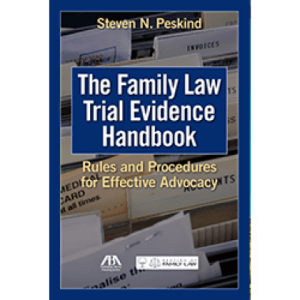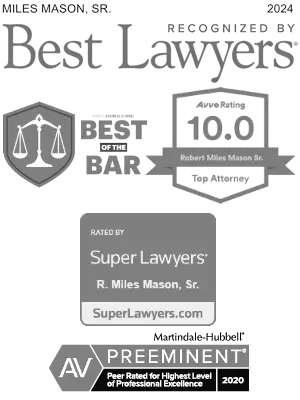The Family Law Trial Evidence Handbook by Peskind | Review
- At August 11, 2019
- By Miles Mason
- In Recommended Reading
 0
0
Book review for the December 2013 Tennessee Bar Journal. Copyright 2019 Tennessee Bar Journal and Miles Mason Family Law Group, PLC. Reprinted with permission.

The Family Law Trial Evidence Handbook: Rules and Procedures for Effective Advocacy
The Family Law Trial Evidence Handbook: Rules and Procedures for Effective Advocacy
by Steven Nathan Peskind, published by ABA Family Law Section.
Book review by Miles Mason, Sr.
Steven Peskind has been practicing law for well over 30 years and is principal of the Peskind Law Firm in St. Charles, Illinois. Nationally recognized as an author and speaker on family law topics, he is a Fellow of the American Academy of Matrimonial Lawyers, elected member of the American Law Institute, and faculty member of the annual ABA Family Law Trial Advocacy Institute. Peskind fully appreciates effective advocacy in family law litigation.
According to Peskind, his handbook serves as “a quick counsel table reference for matrimonial lawyers.” His objective was to show litigators “how to get it in and how to keep it out.” He did an admirable job of sharing his trial advocacy skills with other family lawyers.
Selected Federal Rules of Evidence, logically reassembled, are used as the basis for each chapter analysis. Similar to the Uniform Rules of Evidence adopted by the majority of states and Tennessee, the FRE assures the handbook’s utility in multiple jurisdictions.
Every trial lawyer needs a desk reference. This one serves well the unique demands of domestic relations litigation. Peskind’s extensive trial experience comes neatly into play with abundant evidentiary strategies. Clearly, he’s been down this path many times. His writing style conveys the confidence (without arrogance) of the lawyer’s lawyer. Approachable, analytic, direct, and helpful.
Take his discussion on judicial notice of adjudicative facts in Chapter 8. Peskind presents FRE Rule 201, explains its application in a family law context, and mentors the reader with a practice guide. In one example, the goal is admission of income and family support tax calculations generated by a certain computer tax program. First, the author recommends asking the court to notice the reliability of the tax program and, hence, reliability of the calculations. Second, should the court refuse judicial notice, he discusses laying a proper foundation with expert testimony from the publisher’s representative to establish reliability of the tax program. No expert available? Third, he suggests asking opposing counsel to stipulate. No stipulation? Peskind offers a fourth alternative: pose the analysis as a legal argument and offer the exhibit as a demonstrative aid summarizing the facts as applied to the tax law.

Steven N. Peskind hard at work.
In Chapter 13, he encourages litigators to make “creative use” of expert testimony. In every chapter, he offers examples that are likely to be encountered in family court. (“[I]n a child relocation case a psychologist could give an exposition on clinical studies that relate to uprooting adolescents from their home.”) Chapter 14’s examination of witnesses and application of FRE Rules 607 – 615 is excellent on best techniques for direct and cross.
Figuratively, Peskind’s handbook is the mentor. The wizened co-counsel whispering sage advice as to what to do next, and then next.
This is only one of the writing techniques used successfully. The arrangement and inclusiveness of topics (from basic trial process and procedure, to streamlining the admission of evidence) offers value for all practitioners. For the young lawyer litigating child custody with expert witness testimony for the first time; for the seasoned attorney trying to keep damning facebook evidence out. Every chapter offers examples and finishes with practice points that, alone, are worth investment in the book.
Chapter by chapter, Peskind provides bulleted lists with targeted recommendations. The full complement of FRE rules and foundational charts are found in the appendix, followed by a thorough index.
Lending authority to the author’s analysis, Peskind’s primary sources included the practitioner treatise McCormick on Evidence, 6th ed. (Practitioner Treatise Series, Thomson West); Evidentiary Foundations, 7th ed., by E.J. Imwinkelried (LexisNexis), Trial Evidence, 4th ed., by T.A. Mauet and W.D. Wolfson (Wolters Kluwer); and Modern Trial Advocacy, 4th ed., by S. Lubet (NITA). All of which are well-respected authorities and a compliment to any trial lawyer’s resource library.
The logic, organization, and sheer utility of this handbook, along with pertinent family law examples, make it an ideal quick counsel table reference for the matrimonial lawyer. In another year, I envision my copy with many dog-eared sections and scribbled notations in the margins.









